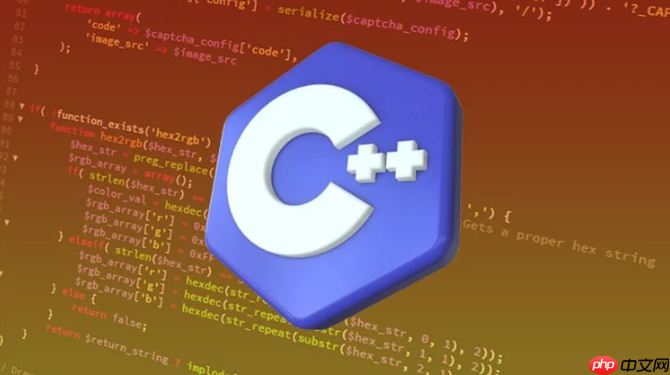自定义STL分配器可控制C++容器内存行为,用于性能优化或内存池管理。需满足接口要求:定义value_type、allocate/deallocate分配内存、construct/destroy处理对象构造析构,支持rebind适配类型。示例中MyAllocator重载new/delete并打印日志,应用于vector时触发分配信息输出,实现简单但完整。高级场景可用内存池减少系统调用,提升频繁小对象分配效率,适用于游戏或高频交易系统。

在C++中,自定义STL分配器(Allocator)可以让你控制容器的内存分配行为。比如用于性能优化、内存池管理或调试内存泄漏。标准库容器如 std::vector、std::list 等都支持通过模板参数传入自定义分配器。
一个符合STL规范的分配器需要满足一些基本接口要求。虽然C++17后对分配器的要求有所简化,但核心成员仍然包括:
下面是一个通用的自定义分配器示例,使用全局 ::operator new 和 ::operator delete,但你可以替换成内存池或其他机制。
立即学习“C++免费学习笔记(深入)”;
#include <iostream>
#include <vector>
#include <memory>
<p>template<typename T>
class MyAllocator {
public:
using value_type = T;
using pointer = T<em>;
using const_pointer = const T</em>;
using reference = T&;
using const_reference = const T&;
using size_type = std::size_t;
using difference_type = std::ptrdiff_t;</p><pre class='brush:php;toolbar:false;'>// C++17 起使用 type alias 替代 rebind
template<typename U>
struct rebind {
using other = MyAllocator<U>;
};
// 构造函数(必须提供默认构造)
MyAllocator() noexcept = default;
// 支持不同类型的转换构造(STL可能用到)
template<typename U>
MyAllocator(const MyAllocator<U>&) noexcept {}
// 分配原始内存,不构造对象
pointer allocate(size_type n) {
std::cout << "Allocating " << n << " elements of size " << sizeof(T) << std::endl;
if (n == 0) return nullptr;
pointer p = static_cast<pointer>(::operator new(n * sizeof(T)));
return p;
}
// 释放内存,不调用析构
void deallocate(pointer p, size_type n) noexcept {
std::cout << "Deallocating " << n << " elements" << std::endl;
::operator delete(p);
}
// 构造对象(C++17 推荐实现)
template<typename U, typename... Args>
void construct(U* p, Args&&... args) {
new(p) U(std::forward<Args>(args)...);
}
// 析构对象
template<typename U>
void destroy(U* p) {
p->~U();
}
// 比较两个分配器是否相等(一般无状态分配器返回true)
bool operator==(const MyAllocator&) const { return true; }
bool operator!=(const MyAllocator&) const { return false; }};
// 非成员函数(可选) template<typename T> bool operator==(const MyAllocator<T>& a, const MyAllocator<T>& b) { return true; }
template<typename T> bool operator!=(const MyAllocator<T>& a, const MyAllocator<T>& b) { return false; }
将上面的分配器用于 std::vector:
立即学习“C++免费学习笔记(深入)”;
int main() {
std::vector<int, MyAllocator<int>> vec;
<pre class='brush:php;toolbar:false;'>vec.push_back(10);
vec.push_back(20);
vec.push_back(30);
for (const auto& v : vec) {
std::cout << v << " ";
}
std::cout << std::endl;
return 0;}
输出示例:
Allocating 1 elements of size 4 Allocating 2 elements of size 4 Allocating 4 elements of size 4 10 20 30 Deallocating 4 elements
如果你希望进一步提升性能,可以实现基于内存池的分配器。例如预先分配一大块内存,allocate 时从中切分,避免频繁系统调用。
关键点:
allocate/deallocate 使用内部缓冲区alignas 或 std::aligned_storage)这种分配器适合频繁小对象分配的场景,比如游戏引擎或高频交易系统。
基本上就这些。自定义分配器不复杂,但容易忽略细节,尤其是构造/析构语义和比较操作。只要遵循STL规范,就能安全集成到标准容器中。
以上就是c++++怎么编写一个自定义的STL分配器_c++自定义allocator内存分配器实现的详细内容,更多请关注php中文网其它相关文章!

c++怎么学习?c++怎么入门?c++在哪学?c++怎么学才快?不用担心,这里为大家提供了c++速学教程(入门到精通),有需要的小伙伴保存下载就能学习啦!

Copyright 2014-2025 https://www.php.cn/ All Rights Reserved | php.cn | 湘ICP备2023035733号